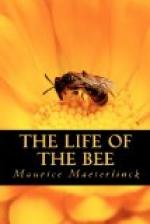Does an analogous work on the bee exist? I believe I have read almost all that has been written on bees; but of kindred matter I know only Michelet’s chapter at the end of his book “The Insect,” and Ludwig Buchner’s essay in his “Mind in Animals.” Michelet merely hovers on the fringe of his subject; Buchner’s treatise is comprehensive enough, but contains so many hazardous statements, so much long-discarded gossip and hearsay, that I suspect him of never having left his library, never having set forth himself to question his heroines, or opened one of the many hundreds of rustling, wing-lit hives which we must profane before our instinct can be attuned to their secret, before we can perceive the spirit and atmosphere, perfume and mystery, of these virgin daughters of toil. The book smells not of the bee, or its honey; and has the defects of many a learned work, whose conclusions often are preconceived, and whose scientific attainment is composed of a vast array of doubtful anecdotes collected on every side. But in this essay of mine we rarely shall meet each other; for our starting-point, our aim, and our point of view are all very different.
[2]
The bibliography of the bee (we will begin with the books so as to get rid of them as soon as we can and go to the source of the books) is very extensive. From the beginning this strange little creature, that lived in a society under complicated laws and executed prodigious labours in the darkness, attracted the notice of men. Aristotle, Cato, Varro, Pliny, Columella, Palladius all studied the bees; to say nothing of Aristomachus, who, according to Cicero, watched them for fifty-eight years, and of Phyliscus, whose writings are lost. But these dealt rather with the legend of the bee; and all that we can gather therefrom—which indeed is exceedingly little—we may find condensed in the fourth book of Virgil’s Georgics.
The real history of the bee begins in the seventeenth century, with the discoveries of the great Dutch savant Swammerdam. It is well, however, to add this detail, but little known: before Swammerdam a Flemish naturalist named Clutius had arrived at certain important truths, such as the sole maternity of the queen and her possession of the attributes of both sexes, but he had left these unproved. Swammerdam founded the true methods of scientific investigation; he invented the microscope, contrived injections to ward off decay, was the first to dissect the bees, and by the discovery of the ovaries and the oviduct definitely fixed the sex of the queen, hitherto looked upon as a king, and threw the whole political scheme of the hive into most unexpected light by basing it upon maternity. Finally he produced woodcuts and engravings so perfect that to this day they serve to illustrate many books on apiculture. He lived in the turbulent, restless Amsterdam of those days, regretting “Het Zoete Buiten Leve “—The Sweet Life of the Country—and died, worn-out




